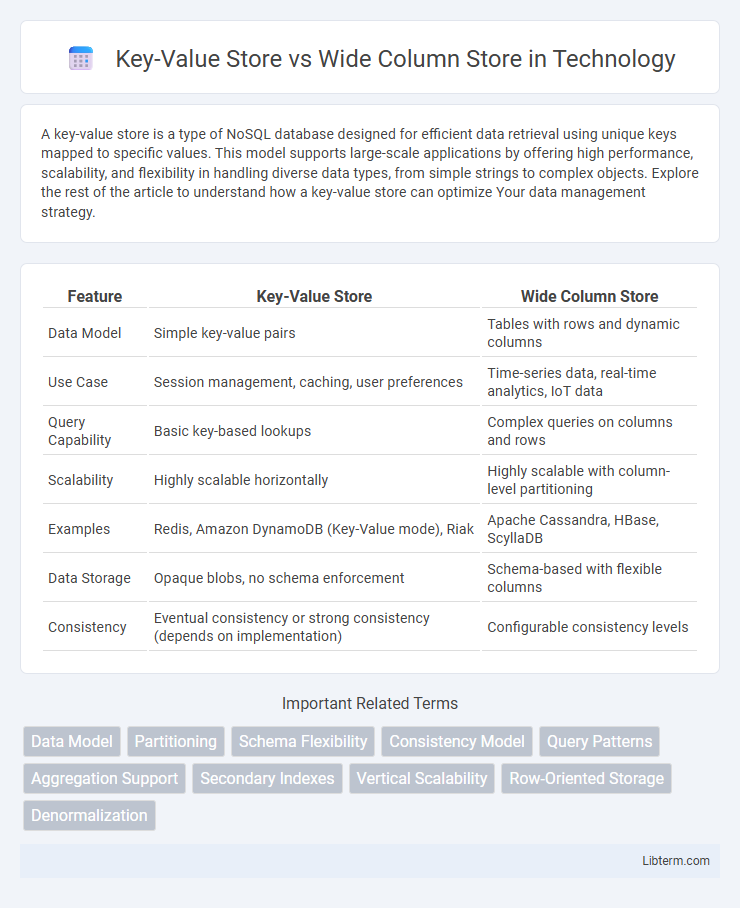A key-value store is a type of NoSQL database designed for efficient data retrieval using unique keys mapped to specific values. This model supports large-scale applications by offering high performance, scalability, and flexibility in handling diverse data types, from simple strings to complex objects. Explore the rest of the article to understand how a key-value store can optimize Your data management strategy.
Table of Comparison
| Feature | Key-Value Store | Wide Column Store |
|---|---|---|
| Data Model | Simple key-value pairs | Tables with rows and dynamic columns |
| Use Case | Session management, caching, user preferences | Time-series data, real-time analytics, IoT data |
| Query Capability | Basic key-based lookups | Complex queries on columns and rows |
| Scalability | Highly scalable horizontally | Highly scalable with column-level partitioning |
| Examples | Redis, Amazon DynamoDB (Key-Value mode), Riak | Apache Cassandra, HBase, ScyllaDB |
| Data Storage | Opaque blobs, no schema enforcement | Schema-based with flexible columns |
| Consistency | Eventual consistency or strong consistency (depends on implementation) | Configurable consistency levels |
Introduction to Key-Value Stores and Wide Column Stores
Key-Value Stores organize data as simple pairs of keys and values, offering fast read/write operations ideal for caching and session management. Wide Column Stores extend this concept by structuring data into rows and dynamic columns grouped into families, providing flexible schema design for large-scale analytical workloads. Both models support distributed storage but differ in data modeling, with Key-Value Stores focusing on straightforward key-based retrieval and Wide Column Stores enabling complex queries across multiple columns.
Data Modeling: Key-Value vs Wide Column Structures
Key-Value stores organize data as simple pairs of unique keys and their associated values, ideal for straightforward lookup and retrieval without predefined schema constraints. Wide Column stores structure data into rows and dynamic columns grouped into column families, enabling flexible, sparse, and hierarchical data modeling suitable for complex queries and aggregation. While Key-Value stores excel in fast, single-item access scenarios, Wide Column stores offer enhanced modeling capabilities for multi-attribute queries and large-scale analytical workloads.
Use Cases: When to Choose Key-Value Stores
Key-value stores excel in use cases requiring ultra-fast, simple read and write operations such as caching, session management, and real-time analytics due to their schema-less design and efficient key-based access. These databases are ideal for applications needing high scalability and low latency, including gaming leaderboards, user preferences, and shopping carts. They outperform wide-column stores when the data model consists primarily of simple key-value pairs without complex querying or relationships.
Use Cases: Ideal Scenarios for Wide Column Stores
Wide Column Stores excel in managing large-scale, sparse datasets with variable schema, making them ideal for time-series data, IoT applications, and real-time analytics where high write and read throughput is critical. Their ability to efficiently store and query columns independently supports scenarios such as recommendation engines, content management systems, and social media platforms. Use cases requiring horizontal scaling and flexible schema design benefit significantly from Wide Column Stores like Apache Cassandra and HBase.
Performance and Scalability Comparison
Key-value stores excel in performance with rapid read and write operations due to their simple data model, making them ideal for caching and session management at massive scale. Wide column stores offer enhanced scalability and flexibility by organizing data in tables, rows, and dynamic columns, optimizing query performance for large, distributed datasets in analytics and IoT applications. The choice depends on the use case: key-value stores prioritize low-latency access, while wide column stores balance complex querying capabilities with horizontal scalability across extensive clusters.
Query Flexibility and Data Retrieval
Key-Value Stores excel in fast, simple data retrieval using unique keys, ideal for scenarios requiring quick lookups with minimal query complexity. Wide Column Stores offer greater query flexibility by allowing efficient read and write operations across large datasets with dynamic column families, supporting complex queries and aggregations. This design enables Wide Column Stores to handle multi-dimensional data retrieval better than Key-Value Stores, making them suitable for analytics and large-scale distributed databases.
Consistency, Availability, and Partition Tolerance
Key-Value Stores emphasize high availability and partition tolerance by providing eventual consistency, making them suitable for use cases requiring fast reads and writes across distributed systems. Wide Column Stores balance consistency and availability with tunable consistency levels, enabling more flexible control over data accuracy and replication latency. Both database types address the CAP theorem differently: Key-Value Stores prioritize availability and partition tolerance, while Wide Column Stores offer configurable trade-offs between consistency and availability depending on application needs.
Popular Technologies: Key-Value vs Wide Column Examples
Popular key-value store technologies include Redis, Amazon DynamoDB, and Riak, which excel in simple, fast retrieval of values based on unique keys. Wide column stores like Apache Cassandra, HBase, and ScyllaDB offer scalable solutions for handling large datasets with flexible schema designs, optimized for analytical queries across wide, sparse tables. Both models support distributed architectures but cater to different use cases: key-value stores prioritize rapid lookups and session management, while wide column stores handle complex, multi-dimensional data modeling for big data applications.
Cost and Maintenance Considerations
Key-Value Stores typically offer lower cost and simpler maintenance due to their straightforward data model and minimal indexing requirements, making them ideal for high-performance use cases with limited query complexity. Wide Column Stores, while more expensive and complex to maintain because of their schema flexibility and support for multi-dimensional queries, provide greater scalability and querying capabilities suitable for large, distributed datasets. Organizations must balance the trade-off between cost-efficiency in Key-Value Stores and the advanced functionality offered by Wide Column Stores when planning infrastructure investments.
Conclusion: Choosing the Right Store for Your Needs
Key-value stores offer rapid, efficient retrieval for simple query patterns, making them ideal for caching and session management. Wide column stores excel in handling large-scale, sparse datasets with flexible schema designs, perfect for analytic and time-series applications. Selecting the right storage solution depends on data complexity, query requirements, and scalability needs.
Key-Value Store Infographic

 libterm.com
libterm.com